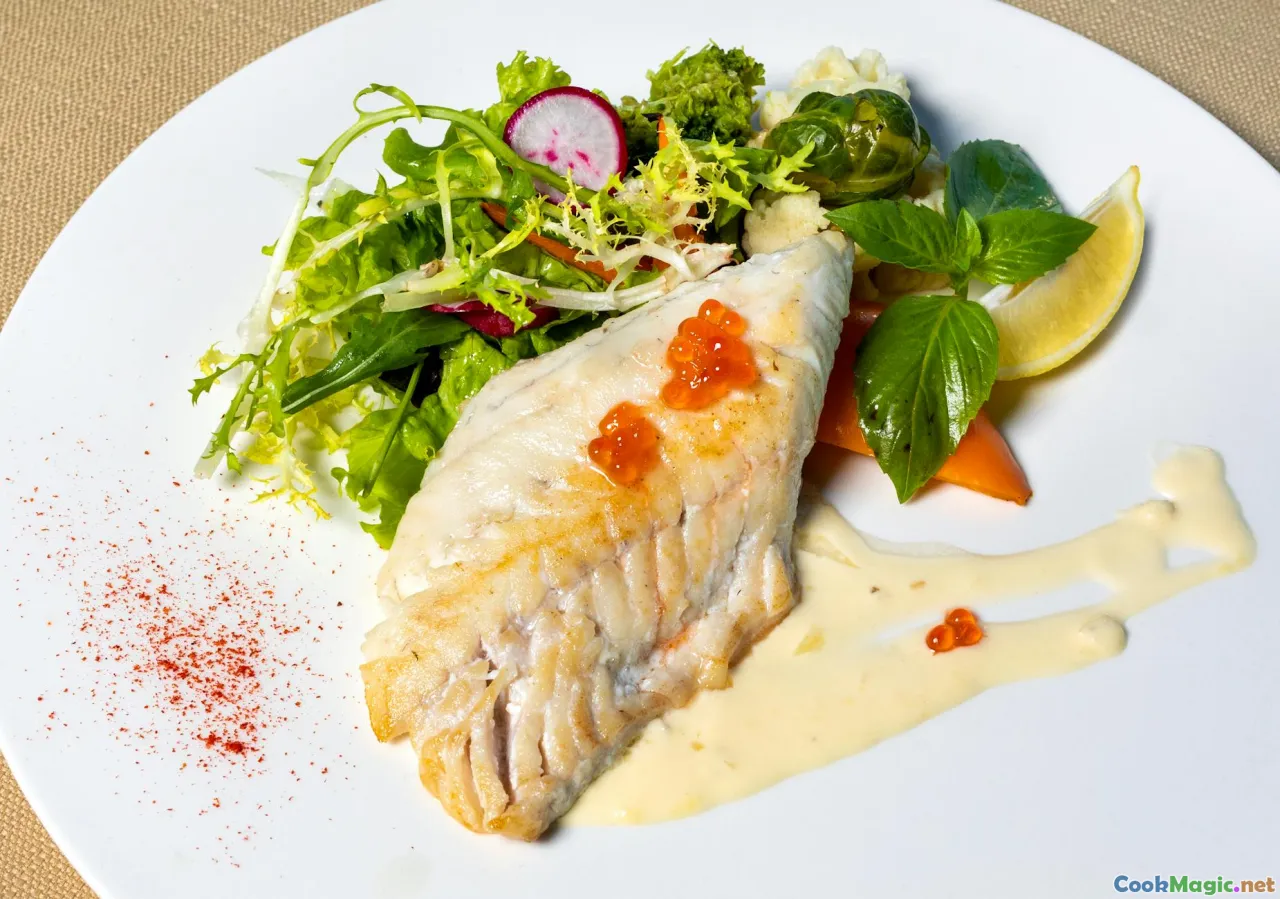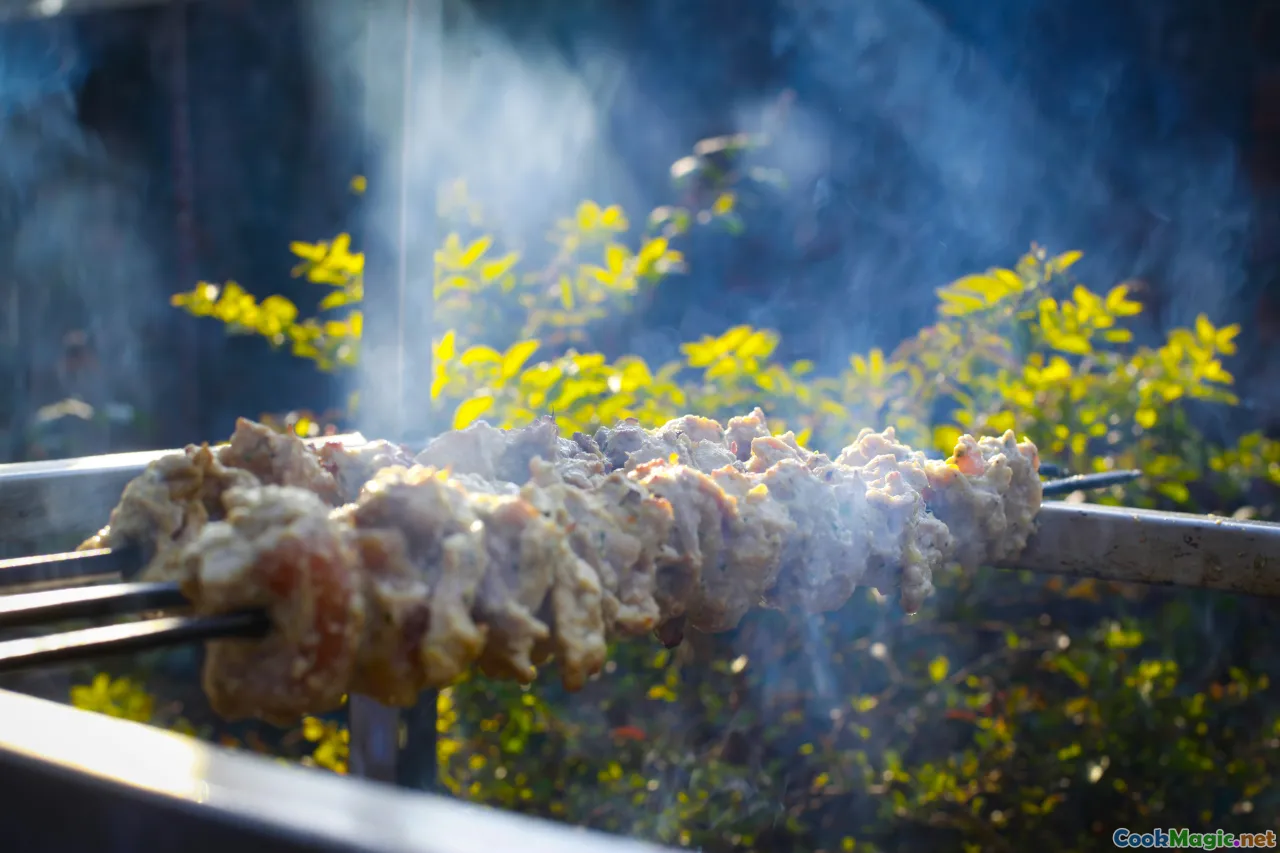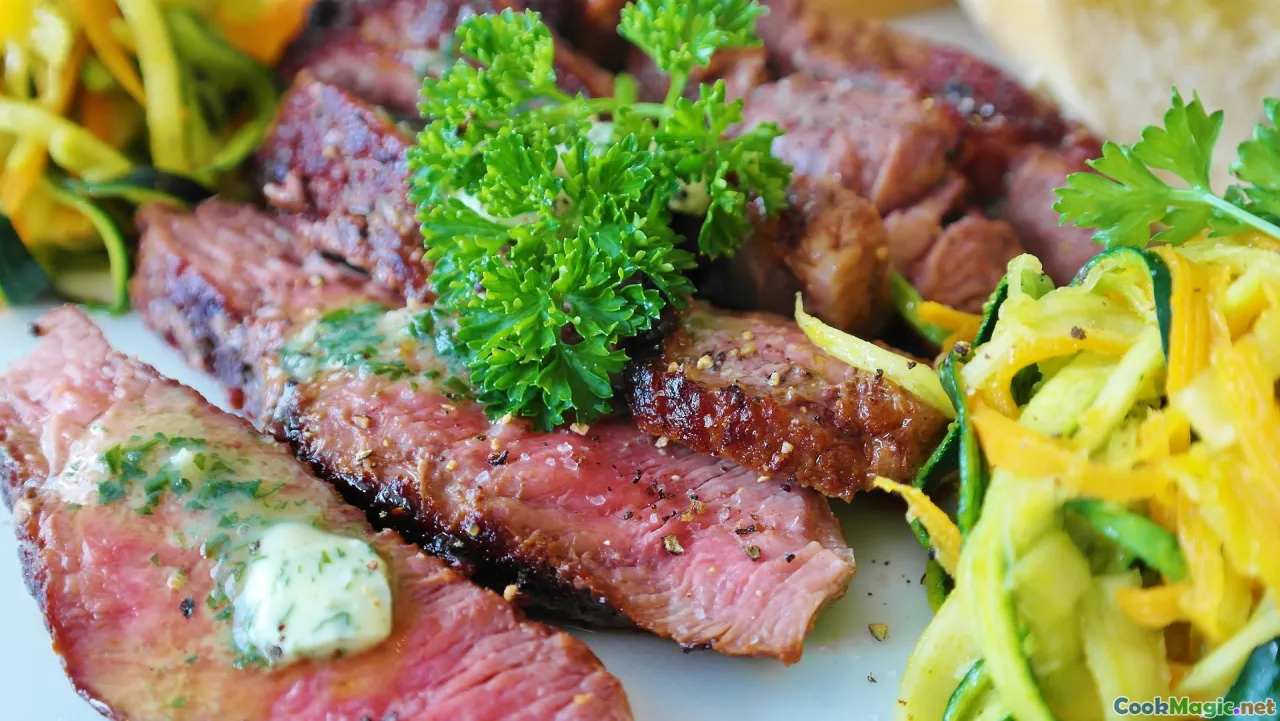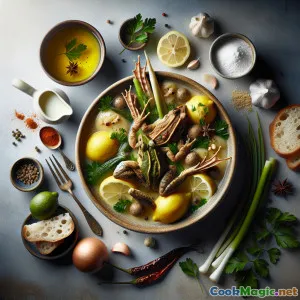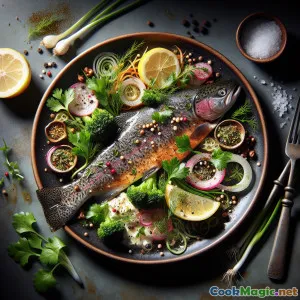
드리나 강의 송어와 야생 허브 및 레몬
(Drina Trout with Wild Herbs and Lemon)
(0 리뷰)재료
-
4 fillets 피부 있는 송어 필레
(About 180–220g each, pin bones removed)
-
1.5 tsp 코셔 소금
(맛에 맞게 조절하세요)
-
1 tsp 신선하게 갈은 검은 후추
(Coarsely ground for better crust)
-
3 cloves 다진 마늘
(Wild garlic (sremuš) if available)
-
1 medium 레몬
(Zest for crust, slices for serving)
-
20 grams 신선한 파슬리, 곱게 다진 것
(Flat-leaf preferred)
-
15 grams 신선한 딜, 곱게 다진 것
(Stems can be used for basting)
-
1 tbsp 신선한 타임 잎(야생 타임)
(Use half if thyme is very pungent)
-
30 grams 얇게 썬 실파(대파)
(White and green parts)
-
2 tbsp 엑스트라 버진 올리브 오일
(Adds fruitiness to herb crust)
-
30 grams 무염 버터
(For basting and nutty flavor)
-
60 ml 드라이 화이트 와인 또는 라키야
(Deglaze and perfume the pan)
-
40 grams 잘게 부순 호두
(Balkan touch; gluten-free crunch)
-
1 tsp 달콤한 파프리카
(온기와 색을 더한다)
-
0.5 tsp 으깬 주니퍼 베리
(Echoes forested riverbanks)
-
2 leaves 월계수 잎
(For aromatic basting)
-
120 grams 발칸 스타일의 플레인 요거트
(For quick herb sauce)
-
60 grams 강판에 간 오이, 물기를 짜낸 것
(Keeps sauce fresh and crisp)
-
1 tsp 꿀
(Balances lemony tang in sauce)
-
30 grams 물냉이 또는 야생 소렐
(Peppery garnish to finish)
(About 180–220g each, pin bones removed)
(맛에 맞게 조절하세요)
(Coarsely ground for better crust)
(Wild garlic (sremuš) if available)
(Zest for crust, slices for serving)
(Flat-leaf preferred)
(Stems can be used for basting)
(Use half if thyme is very pungent)
(White and green parts)
(Adds fruitiness to herb crust)
(For basting and nutty flavor)
(Deglaze and perfume the pan)
(Balkan touch; gluten-free crunch)
(온기와 색을 더한다)
(Echoes forested riverbanks)
(For aromatic basting)
(For quick herb sauce)
(Keeps sauce fresh and crisp)
(Balances lemony tang in sauce)
(Peppery garnish to finish)
영양 정보
- 인분: 4
- 1인분 크기: 1 fillet (200g) with sauce
- Calories: 390 kcal
- Carbohydrates: 7 g
- Protein: 39 g
- Fat: 33 g
- Fiber: 1.5 g
- Sugar: 3 g
- Sodium: 520 mg
- Cholesterol: 95 mg
- Calcium: 120 mg
- Iron: 1.6 mg
조리법
-
1 - Prepare and dry the trout:
Pat fillets very dry with paper towels. Lightly score the skin with 3–4 shallow diagonal cuts to prevent curling. Season both sides with salt and pepper.
-
2 - Make the herb crust:
In a bowl, combine garlic, lemon zest, parsley, dill, thyme, spring onion, paprika, juniper (if using), olive oil, and crushed walnuts. Mix to a thick paste.
-
3 - Marinate briefly:
Spread a thin layer of the herb paste over the flesh side of each fillet. Let stand 8–10 minutes while you preheat your pan or grill.
-
4 - Preheat pan or grill:
Heat a heavy cast-iron skillet over medium-high until shimmering hot, or preheat a grill to medium-high (about 230°C).
-
5 - Sear skin-side for crispness:
Add half the butter to the hot pan. Lay trout skin-side down. Press gently with a spatula for 30 seconds to keep contact. Cook 3–4 minutes until the skin is crisp and the fish turns opaque two-thirds up.
-
6 - Flip, baste, and perfume:
Flip fillets. Add remaining butter, bay leaves, and the wine or rakija to deglaze. Tilt the pan and baste the trout with the foaming butter for 2–3 minutes until just cooked (52–54°C internal).
-
7 - Mix quick yogurt-herb sauce:
Stir yogurt with a squeeze of lemon juice, grated cucumber, a pinch of salt, and a touch of honey. Adjust acidity and salt to taste.
-
8 - Rest and Serve:
Transfer trout to warm plates and rest 2 minutes. Spoon yogurt sauce alongside, scatter watercress or sorrel, and finish with lemon slices and any pan juices.
-
9 - Optional vine-leaf grill method:
For an authentic riverbank style, wrap each fillet in two rinsed vine leaves brushed with oil. Grill 3 minutes per side over hot embers; unwrap to serve.
Pat fillets very dry with paper towels. Lightly score the skin with 3–4 shallow diagonal cuts to prevent curling. Season both sides with salt and pepper.
In a bowl, combine garlic, lemon zest, parsley, dill, thyme, spring onion, paprika, juniper (if using), olive oil, and crushed walnuts. Mix to a thick paste.
Spread a thin layer of the herb paste over the flesh side of each fillet. Let stand 8–10 minutes while you preheat your pan or grill.
Heat a heavy cast-iron skillet over medium-high until shimmering hot, or preheat a grill to medium-high (about 230°C).
Add half the butter to the hot pan. Lay trout skin-side down. Press gently with a spatula for 30 seconds to keep contact. Cook 3–4 minutes until the skin is crisp and the fish turns opaque two-thirds up.
Flip fillets. Add remaining butter, bay leaves, and the wine or rakija to deglaze. Tilt the pan and baste the trout with the foaming butter for 2–3 minutes until just cooked (52–54°C internal).
Stir yogurt with a squeeze of lemon juice, grated cucumber, a pinch of salt, and a touch of honey. Adjust acidity and salt to taste.
Transfer trout to warm plates and rest 2 minutes. Spoon yogurt sauce alongside, scatter watercress or sorrel, and finish with lemon slices and any pan juices.
For an authentic riverbank style, wrap each fillet in two rinsed vine leaves brushed with oil. Grill 3 minutes per side over hot embers; unwrap to serve.
드리나 강의 송어와 야생 허브 및 레몬 :에 대한 자세한 정보
Drina River Trout with Herbs
This dish celebrates the clear, fast waters of the Drina—a river that shapes the culinary memory of both Bosnia and Herzegovina and Serbia. Along its pebbled banks, trout are often cooked as simply and as freshly as possible: skin crackling over heat, perfumed with foraged herbs, and brightened with lemon. My version preserves that spirit while translating it into a modern kitchen, with a crisp herb crust and a light yogurt sauce that recalls the dairy tradition of the region.
What makes this trout special
- Wild herb profile: Parsley, dill, and thyme form the backbone, but the dish lights up if you can find wild garlic (sremuš) or wild thyme. Juniper hints at nearby forests; walnuts add a Balkan signature and a gentle crunch.
- Texture contrasts: The goal is glassy, crisp skin over tender, pearly flesh. A quick sear and steady heat are your allies. The yogurt sauce cools and softens the richness of butter-basted fish.
- Riverbank inspiration: Deglazing with a splash of white wine—or rakija for local flair—creates an aromatic pan sauce that whispers of campfires and cool river air.
Chef’s tips for success
- Dry fish is crisp fish: Moisture is the enemy of a crackling skin. Pat the fillets thoroughly and score lightly so they don’t curl.
- Control heat: Medium-high is ideal. Too high and herbs scorch; too low and skin steams. If using a grill, preheat until you can hold your hand 5 seconds above the grate.
- Gentle flipping: Use a thin fish spatula and wait until the edges are golden and release naturally. If the fish sticks, give it 30 seconds more.
- Don’t overdo the herbs: Spread a thin layer of herb paste. Overloading can cause browning to tip into bitterness.
- Internal temperature: For succulent trout, aim for 52–54°C (125–130°F). Residual heat will finish the job during the short rest.
- Sauce balance: Cucumber and yogurt calm the herbaceous notes; a whisper of honey balances lemon’s acidity without turning the sauce sweet.
Substitutions and variations
- Fish: Arctic char or small salmon fillets work well if trout isn’t available. Adjust cooking time for thicker pieces.
- Herbs: If you’re limited to dried herbs, use one-third the amount and bloom them briefly in warm olive oil before mixing into the paste.
- Nuts: Replace walnuts with ground hazelnuts or almond meal. For nut-free, use fine polenta or crushed pumpkin seeds.
- Deglazing: If avoiding alcohol, a splash of fish stock with a squeeze of lemon works beautifully.
- Dairy-free: Swap butter for more olive oil and skip the yogurt sauce; brighten with extra lemon and a few capers.
Make-ahead notes
- The herb paste can be made up to 24 hours in advance; keep chilled and bring to room temperature before using.
- Dry and season the fish up to 30 minutes ahead. Sear just before serving for the best texture.
Serving ideas
Plate the trout over a bed of grilled spring onions or charred lemon halves. Add boiled new potatoes tossed with dill and olive oil, or a simple salad of cucumbers, tomatoes, and onions dressed with red wine vinegar—an homage to salads common in the Drina valley.
Cultural thread
Trout has long been prized in the upper Drina, where cold tributaries feed into the river and create ideal habitat. Village gatherings often center around fresh fish, cooked quickly and shared generously. Vine leaves—abundant in backyard vines—serve as makeshift grill wrappers, imparting a gentle grassy note while protecting the fish from direct flame. The walnuts nod to hill orchards, while dill and parsley point to kitchen gardens where cooks snip herbs moments before the meal.
Why this technique works
- Scoring and drying ensure contact and crispness.
- A thin herb paste integrates into the surface, toasting instead of burning.
- Basting with butter infuses flavor while keeping the flesh moist; the brief deglaze lifts fond into a quick, shimmering sauce.
Pairings
- Drink: A chilled Žilavka or Graševina echoes the wine used in the pan. Beer lovers can choose a crisp pilsner.
- Sides: Buckwheat porridge with herbs, roasted peppers, or grilled flat beans are excellent companions.
Final thought
This is food you can cook by feel: listen for the faint crackle of skin, watch for the turn of color, and follow the perfume rising from the pan. In minutes, you’ll have a plate that tastes like fresh air and sunlit water—simple, elemental, and deeply satisfying.

